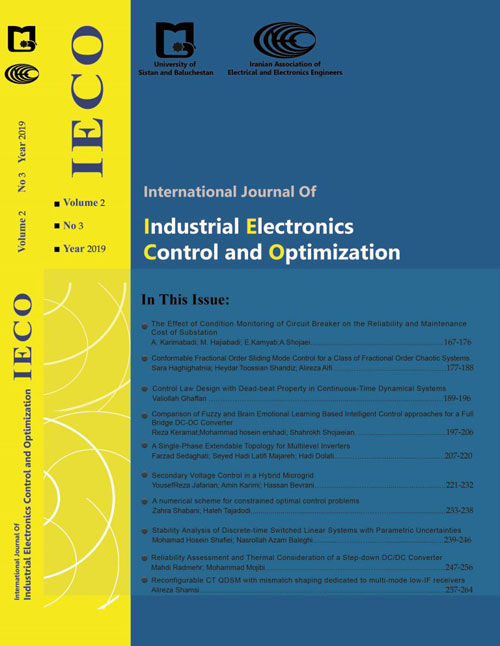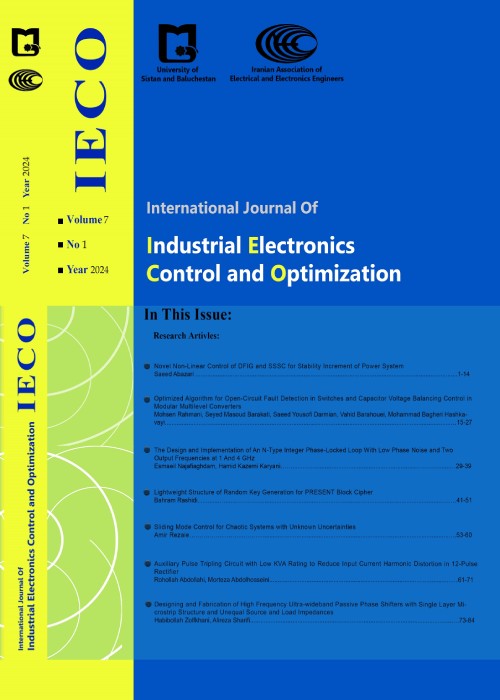فهرست مطالب

International Journal of Industrial Electronics, Control and Optimization
Volume:2 Issue: 3, Summer 2019
- تاریخ انتشار: 1398/04/10
- تعداد عناوین: 10
-
-
Pages 167-176Over the recent years, a number of new maintenances methods for high voltage substations have been introduced to reduce the number of substation events. The primary purpose of the present study is to presents a Cost-benefit analysis for Circuit-Breakers (CBS) in a substation equipped with Condition Monitoring (CM) devices. To this end, a mathematical formulation to categorize and model equipment failures based on their severity is developed. By CM, some of severity failures, named major failures, can be detected early, and corrected as the minor failure. This formulation quantifies the effect of CM devices on the outage rate and Predictive Maintenance (PDM) rate of the equipment. The PDM rate is used to modify the Markov maintenance model for the equipment. The proposed modified Markov model quantifies the effect of CM on the maintenance costs and lifetime of CB. The New Markov model is compared with the Preventive Maintenance (PM) model. Expected Energy Not Supply (EENS) and reliability Cost are calculated with and without CM on CBs. Finally, the proposed model is applied on the CBs of 400/132/20KV substation in the Khorasan Regional Electricity Company (KREC) in Iran. The obtained results show that CM on CBs of substations improves the EENS and reliability cost by 82.43 %. Moreover, the maintenance cost of the proposed model shows an improvement of 9.07 % compared to PM model. Finally, the total annual costs show an improvement of 80.67% due to CM on CBs.Keywords: Condition Monitoring, reliability, Circuit Breakers
-
Pages 177-188In this paper, a novel conformable fractional order (FO) sliding mode control technique is studied for a class of FO chaotic systems in the presence of uncertainties and disturbances. First, a novel FO nonlinear surface based on conformable FO calculus is proposed to design the FO sliding mode controller. Then, asymptotic stability of the controller is derived by means of the Lyapunov direct method via conformable FO operators. The stability analysis is performed in the sliding and reaching phase. In addition, the realization of reaching phase is guaranteed in finite time and the reaching time is calculated analytically. The proposed control approach has some superiorities. Reduction of the chattering phenomenon, high robustness against the uncertainty and external disturbance, and fast convergence speed are the main advantages of the proposed control scheme. Moreover, it has simple calculations because of using conformable FO operators in the control design. The numerical simulations verify the efficiency of the proposed controller.Keywords: Fractional calculus, Chaotic system, Lyapunov direct method, Conformable fractional order sliding mode controller
-
Pages 189-196In this paper, an open loop control scheme is developed in order to design a dead-beat control effort in the high order continuous-time systems. The dead-beat control is really a finite-time control law. In this method, the input signal has been manually selected such that the output signal becomes constant in a finite time. In the LTI systems, having known the step response, a control signal could be exactly selected such a way that the control objective would be met in a finite time. For this end, the dead-beat control problem is firstly investigated in a standard first order system. Then a similar problem is studied in the second order systems. Finally a general design framework would be developed to obtain a dead-beat control policy in the high order continuous-time systems. In the proposed method, the control design problem is deliberately converted into the solution of a linear matrix equation. Therefore the control signal would be determined by solving such an algebraic equation. The proposed procedure is applied in some continuous-time LTI systems. The simulation results are shown effectiveness of the suggested methods for designing of a finite-time control law in the continuous-time systems.Keywords: LTI control system, dead-beat control, continuous-time systems, Posicast control
-
Pages 197-206In this paper, the Brain Emotional Learning Based Intelligent Controller (BELBIC) and fuzzy controller were used to control output voltage of the full bridge DC-DC converter. The converter is presented by its state space averaged model assuming that it operates in the continuous conduction mode (CCM). A comparison was also made between the results. The effectiveness of control approaches are demonstrated by the uncertainty of system parameters and acceptable load variations. The performance of the BEBLIC and fuzzy controller in controlling the output voltage of the full bridge DC-DC converter was satisfactory. Since these controllers are not designed to reduce error to zero, it is not possible to claim that the error rate is precisely zero. Compared to the fuzzy controller, the BELBIC shows negligible overshoots and fluctuations. Both controllers reach stabilization almost at once. It is, therefore, concluded that the BELBIC acts better than the fuzzy controller. Considering the uncertainty of system parameters (including inductance, capacitance, and input voltage and acceptable variations of load), BELBIC acts better than the fuzzy controller.Keywords: BELBIC, DC-DC converter, Fuzzy controller, Robustness
-
Pages 207-220This paper presents a single-phase topology for multilevel inverters with minimum number of switching devices. The proposed topology significantly reduces the number of DC voltage sources, switches, and power diodes as the number of output voltage levels increases. The proposed multilevel inverter is constructed using series-connection of multilevel strings. Suggested multilevel string is composed of multiple basic switching units. The proposed multilevel inverter has extendable configuration that increases the number of output voltage levels more and more by adding more stages. The proposed multilevel inverter would be implemented in both symmetric and asymmetric configurations. Two different algorithms are introduced for determination of magnitude of DC voltage sources to reach the maximum number of output voltage levels with minimum number of semiconductor devices. Important characteristics of both symmetric and asymmetric configurations are extracted and compared with similar multilevel inverter topologies. Finally, a prototype of the proposed multilevel inverter is simulated and implemented experimentally to verify operation of the proposed multilevel inverter.Keywords: Inverter, Multilevel, H-bridge converter, Extendable configuration
-
Pages 221-232Compared to individual DC or AC microgrids, the Hybrid microgrids (HMGs) are more efficient and inexpensive due to eliminating of multiple DC-AC-DC conversions. In HMGs, where AC loads are supplied by DC link, load demand disturbance has direct negative effects on the DC link voltage. In this study, primary and secondary controllers are applied to realize suitable operation conditions and control the microgrid converters. Each converter has primary controller to compensate the demand power fluctuations. The secondary controller is also designed for extra demand varieties and sends the proper control signals for primary controllers. The expressed capability of primary controllers can be obtained by designing a simple and robust secondary controller. Hence, the effects of demand fluctuations are eliminated and the system is stabilized. The overall state space model of system is conducted for stability analysis. To demonstrate the proposed controller efficiency, a prototype HMG is modeled and simulated. The stability analysis reveals that the system is stable when the secondary controller tracks the error signal of DC link. Simulation results show that the proposed method could efficiently manage the AC side voltage under load fluctuations.Keywords: Boost chopper, DC link voltage, Inverter, Rectifier, State space modelling
-
Pages 233-238In this paper, a numerical technique is proposed to solve optimal control problems (OPCs) of Volterra integral equations (VIEs). We apply the linear B-spline polynomials to solve OPCs by VIEs. The B-spline function divides the interval into sub-intervals and then built a different approximating polynomial on each sub-interval. In this method, optimal trajectory and control functions are expanded in terms of B-spline functions. The linear B-spline operational matrix of integration and multiplication are utilized in the proposed method.The main characteristic this method is that by using the suggested numerical technique and the related operational matrices, optimal control problem governed by Volterra integral equations is converted to a system of equations. Suffice it to say that this scheme simplifies The main problems and also makes to obtain a good approximate solution for them. In the end, there are two illustrative examples which numerical results show the validity and applicability of our method.Keywords: Optimal control problems, Volterra integral equations, Linear B-spline function, Operational matrix
-
Pages 239-246This paper considers the stability problem of discrete-time switched linear systems in the presence of parametric uncertainties. Parametric uncertainty is sometimes called structured uncertainty because of the structure of the model is known, but some of the parameters are uncertain. From the practical viewpoint, it is important to investigate the robust stability conditions of uncertain switched systems. Therefore, under the assumption of knowing the structure of the uncertainty matrix and based on the common Lyapunov function for the nominal switched system, sufficient conditions for robust exponential stability of the discrete-time uncertain switched system (under any switching signal) are derived. Sufficient conditions are formulated in terms of matrix inequalities for fixed values of some parameters which may be solved via LMI techniques based on numerical methods. Moreover, a procedure is proposed to determine the maximum admissible bounds of the uncertain parameters which characterize the exponential stability of the uncertain switched system. Finally, numerical examples are provided to verify the theoretical results.Keywords: Discrete-time switched systems, parametric uncertainties, exponential stability, LMI
-
Pages 247-256Reliability consideration is always important among the manufacturers of power modules and converters. Before using of power electronic converters into the related application, it is necessary to predict its reliability over time. In the meanwhile, the power loss and heat generated within the power semiconductors play a key role in the lifespan of the whole system. In this paper, a method for assessing the reliability of a step-down DC-DC converter is employed based on the thermal modeling of power semiconductors. As is evident from the used reliability approach, the junction temperature of power semiconductors – diodes and insulated-gate bipolar transistors (IGBTs) – is the most influential factor on the lifetime of power converters. Therefore, the simultaneous influence of switching frequency and duty cycle is analyzed at the same time as a factor for evaluating reliability. A cut-off of 150°C is considered for the maximum allowable junction temperature for the examined IGBT power module. The results show that a failure can be expected after 46,000 hours of operation of the considered power converter. Additionally, 3D curves are presented to illustrate the influence of duty cycle and switching frequency on the reliability of circuit’s components and the overall system. The obtained results confirmed that an increase in switching frequency from 1 kHz to 10 kHz can decrease the circuit’s lifetime almost 22%.Keywords: Thermal modeling, power losses, temperature factor, reliability
-
Pages 257-264A reconfigurable third-order multi-bit continuous-time quadrature delta-sigma modulator (CT-QDSM) with mismatch error correction is reported in this paper. This modulator is designed for a tri-mode WLAN/WCDMA/GSM Low-IF (Intermediate Frequency) receiver. A three-bit quantizer is utilized to achieve the bandwidth (BW) and signal to noise ratio (SNR) required in WLAN/WCDMA standards. In this modulator, the adders are eliminated to optimize the power consumption. The excess loop delay of modulator compensated by half of the sampling period of quantizer. The reconfigurable dynamic element matching (DEM) is proposed to eliminate the mismatch error. Therefore, the I and Q mismatch error are alleviated by designing the data weighted average (DWA) and homogeneous block (HB) circuits for WCDMA/WLAN modes respectively. In addition, the complex_digital to analog converter (C_DAC) is designed to eliminate the mismatch between I and Q paths. Implemented in 180 nm CMOS, achieves 53.6/74.2/81.63 dB SNR and figure-of-merits (FoM) of 0.863/0.495/1.63 pJ/ (conversion step) with a 20/2/0.2 MHz BW for WLAN/WCDMA/GSM operational mode.Keywords: Quadrature delta sigma modulator, WLAN, WCDMA, GSM, Multi standard, Low-IF receiver


